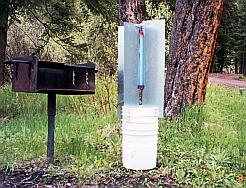Aquatic Invertebrates of Montana

Black Light Traps

These traps are mostly used for monitoring moths that are pests to agriculture. Light traps also take the adults of many aquatic and simiaquatic insects including aquatic Lepidoptera, apparently all species of caddisflies, many species of beetles, bugs and flies, some mayflies, a few stoneflies and the spongillaflies. This is to say they take most species of flying aquatic insects except for the Odonata and alderflies, and in our mountain areas they take few mayflies or stoneflies.
I use a simple home-made trap of 4 metal panels bolted together with room for a 15 or 20 watt florescent light bulb to be fitted in the center. This is fitted into the cut-off top of a 5 gallon plastic bucket, which is then placed into a whole 5 gallon bucket. For overnight use I use soapy water to hold the catch. I discard the large moths in the morning and preserve the rest in 10% formalin. For longer term use, I use soapy water and formalin to hold the catch. A fairly strong mixture of formalin quickly kills the insects and keeps them in good condition. Most of the scales will stay on the moths which really helps in sorting the sample.
There is no better way to inventory caddisflies than with light traps. These may come to light, along with some Diptera and moths even on cool nights. Light traps are not effective on cold nights, during precipitation or when the moon or other bright lights are visible in the area. The moon is most favorable for light traping from about last quarter through the new moon. During this time there is little or no moon visible, at least in the early evening. On those rare hot, dark and calm nights that occur here, there is no better way to get a great many species in a single night. I have many species that are still known only from light trap collections.
Light traps may take dispersing or migrating insects at great distances from suitable habitat, especially in the prairie areas. Some species of caddisflis, such as the Hydropsychidae, have far more females in the trap than males, but males are generally also present and for most species of caddisflies, the sexes are taken more equally. Light traps should be used with care near large rivers as some mayflies and caddisflies may completely burry the trap! Moths might do the same almost anywhere during population outbreakes.
This light trap will also take day-flying insects as a simple interception trap would, and it could be baited to enhance this role. This trap can also take birds, squirrels and frogs, but the rate is low, perhaps about 1 vertebrate per 50 trap days. These could be fenced out, which could also keep out the larger moths.
I have never had the catch in one of these traps flooded or destroyed. The traps must be secured from blowing over- usually tied from above and braced from below. The catch is usually in excellent condition and very clean, except for moths.
The volume of insects may be very great in these traps. I fractionate the catch by size with submerged sieving before picking. Moths scales can be further cleaned from the sample by differential sedimentation in water or dilute waste alcohol, if too many of the specimens float in water. Whole insects will settle to the bottom more quickly than fragments and scales.
23 MAR 1996 D.L. Gustafson
